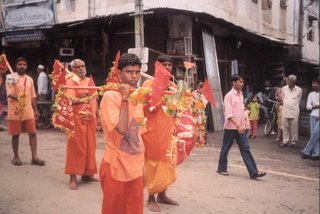Aug 1 2007:
The month of Shravan has begun and I saw scores of Shiva worshippers walking towards Ujjain carrying the holy waters of the Narmada on their shoulders. I am reminded of something I had written last year. Here it is, a repost:
July 2006:


It happened a few days ago. I think it was on Monday 24 July 2006. I was on my scooter in Sanghi Street Mhow when I saw a huge saffron mass heading towards me. It was a group of Kavad Yatris. The worshippers of Shiva who walk barefoot and take the waters of a holy river to a prominent Shiva temple. I parked my scooter at the Kotwali Chowk opposite Oxford Book Depot. I was happy when I saw my camera roll still had a few shots in it.
In this part of India (Malwa and Nimar) the Kavad Yatris take the waters of the Narmada (the Narmada is supposed to be the daughter of Shiva) from the temple towns of Maheshwar or Omkareshwar and go to Ujjain via Mhow and Indore. I have often heard it said that Mhow got its name because it is between Maheshwar and Omkareshwar. There is another theory that Mhow is so named because it is short for Military Headquarters of Western India. I prefer the former theory as the name Mhow is supposed to be older than 1818 - the year the English under John Malcom defeated the Holkars at the Battle of Mahidpur and were given Mhow for a Cantonement.
After reaching Ujjain these worshippers offer the water, which they collect in pitchers and tie at the end of staves, to Lord Shiva at the temple of Mahakaal. The lingam here is a jyotirlinga and is also known as Dakshinmukhi as it is the only jyotirlinga which faces south. It is a tough walk. Omkareshwar and Maheshwar are in the plains of Nimar and these pilgrims ascend almost 70 kms of the Vindhyachal mountains as they reach Mhow on the edge of the Malwa plateau. And they do it barefeet. Even a tough infantryman would say "Well done!" That is the strength that faith can give. There are times I have seen women among the kavadiyas (as they are known). The going from Mhow is relatively smooth as the terrain till Ujjain is mostly plain. It is roughly 23 kms from Mhow to Indore and then another 65 kms or so from Indore to Ujjain.
Many of these kavad yatris are regulars and they time off during Shravan (July) and devote it to Shiva. Malwa and Nimar are areas which are primarily Shiva worshipping. 17 kms from Mhow is the hill temple of Janapao which is famous for its Shiv temple. According to local legend this is where the ashram of Jamadagni the father of Lord Parshuram used to be. It is from this hill that two rivers - the Chambal and the Gambhir originate. The Chambal is a mere trickle here and one would find it hard to believe that after a few hundred kilometres it becomes a river which is associated with violence and dacoits. The Gambhir flows quietly towards Ujjain where it merges with the Kshipra. It is more of a stream as it flows through Mhow. The English had named it Cad's River as it flowed through Mhow. The Army golf course is just besides this river.
I have been seeing these Kavad Yatris ever since I have come to Mhow in 1979. I wonder whether I would be able to take time off during Shravan and walk with them from the Narmada to Mahakaal. If that materialises it would truly be a pilgrimage undertaken from the deepest recesses of my heart.
The procession turned at the end of Sanghi Street and headed down M.G.Road when I intercepted it somewhere near Gujarati Stores. The guru leading it ordered the saffron mass to stop. I was embarassed as I wanted to click them while they were walking. He may well have thought that I was from some local newspaper. The second picture (top, centre)is more natural. It is good that I was carrying my trusted Yashica MF2 that day.